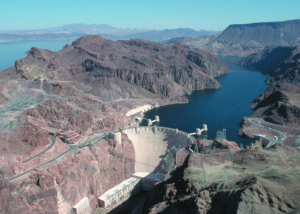I recently participated in a teleconference discussing Colorado energy issues. Over half my home State’s electricity comes from coal. The oil and gas sector supports 213,000 jobs and contributes $25 billion to Colorado’s economy. Still, a majority of our population longs for the day we wean ourselves, relying entirely on renewable energy.
 That means wind and solar to most people. I’ve always thought it strange that renewable advocates dislike hydroelectric power, though rain and runoff are every bit as continuous, predictable, renewable, and free as the wind and sun. Dams and reservoirs have environmental impacts, of course, but so do wind machines and solar panels – both of which also have reliability issues. Now it seems, the former may be able to solve the latter’s problem.
That means wind and solar to most people. I’ve always thought it strange that renewable advocates dislike hydroelectric power, though rain and runoff are every bit as continuous, predictable, renewable, and free as the wind and sun. Dams and reservoirs have environmental impacts, of course, but so do wind machines and solar panels – both of which also have reliability issues. Now it seems, the former may be able to solve the latter’s problem.
The main problem with wind and solar is simple enough; the wind doesn’t always blow and the sun doesn’t always shine – not always when we need it. So despite massive growth in wind and solar installations, meeting demand still requires coal and natural gas plants. That might change if we had the technology to store renewable energy, on a massive utility scale, which always brings the discussion around to batteries.
Battery technology is slowly improving. Companies like LG, Sonnen, and especially Tesla, are marketing batteries that combine with home rooftop solar panels. Tesla’s “Powerwall” is a rechargeable AC-coupled home battery that stores energy during sunny periods and discharges it on demand. Such batteries can supply a home during power outages for 7-8 hours. They are expensive ($5,000-10,000), but they work. So why don’t utilities just install lots of them for commercial-scale use?
As one solar website explains, “The problem is that storing solar and wind power from commercial farms would require warehouses full of massive batteries, and at this size, a major problem becomes apparent – the bigger the battery, the higher the temperature. This makes the probability of dangerous situations… more likely.”
Nevertheless, lithium-ion batteries are being used with solar arrays in several large facilities. Perhaps the largest is Arizona’s Pinal Central Solar Energy Center. A couple hundred Tesla commercial-sized batteries are paired with 258,000 solar panels on 257 acres of land, and can generate 20 Megawatts. It is a $60 million project. What if such expenses were unnecessary, because we’ve had much larger and absolutely reliable batteries for decades?
A seemingly unrelated technology involving hydroelectric dams may offer a simple solution. It is known as “pumped storage” and it has been around for generations.
Pumped storage has long been understood to improve the economics of hydro-dams. Electricity costs more when demand is higher, so the grid experiences peak demand in the daytime and lower demand at night. So, water is run through generators during peak daytime hours when the power sells at a higher price, then pumped back up to the reservoir during the night when power is cheaper.
There are numerous commercial pumped storage systems in the U.S., including the Taum Sauk plant in Missouri, Bath County in Virginia, and Raccoon Mountain in Tennessee. Water stored in an upper reservoir is released through the turbines during high energy demands, and pumped back into the upper reservoir overnight. That same technology is now being considered as a way to turn existing dams into giant batteries for solar and wind power storage, even at the nation’s largest reservoir.
The Hoover Dam Proposal aims to build a wind and solar-powered pump station 20 miles below the dam, to pump water back up to Lake Mead. Water stored in the lake can be released for power on demand, effectively turning the dam into a battery for solar and wind power.
Pumped storage projects have always been constrained by geology, but especially by the federal permitting process, which can take a decade or more. Dams are always controversial because of their environmental impacts, but with already-existing dams, these issues were long since argued, litigated, and resolved. There are 1,756 hydroelectric facilities in the U.S. and another 80,000 unpowered dams, many of which could have turbines installed. They are the most reliable source of energy imaginable. The 50 oldest electric plants in the country are all hydroelectric generators, all of them over 100 years old.
Los Angeles wants the Hoover Dam project completed by 2028. That will be debated for years, but in the end it will make sense if they are serious about renewable energy. Americans will also continue to invest billions in new battery technology, but in the end we may find we’ve had the batteries all along.
A version of this column originally appeared in the Grand Junction Daily Sentinel September 21, 2018.




Comments on this entry are closed.